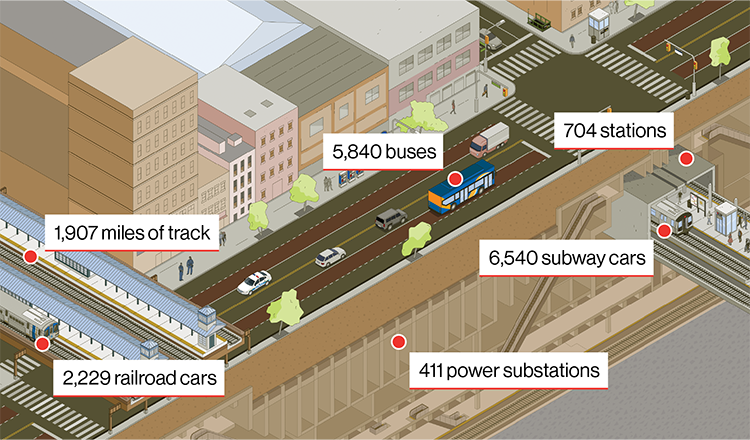Metropolitan Transportation Authority 20-Year Needs Assessment

Metropolitan Transportation Authority 20-Year Needs Assessment
Strategic Communications to Make Transit Asset Needs Compelling in New York City Region
- Conveyed the infrastructure needs of the MTA’s vast array of assets, valued at $1.5 trillion
- Assessed existing state of good repair and asset information for over 100 different asset classes and types
- Collaboration between transportation planners, strategic communications creative professionals and transportation enterprise asset experts
- Custom-designed and user-friendly digital platform
- Rigorous assessment, examination, and integration of discrete asset and capital databases into one cohesive umbrella to promote a unified vision of the MTA
New York City is home to the largest public transit system in the United States, serving millions of customers daily. That prominent size includes needs on a similar scale, with an asset base valued at $1.5 trillion and annual capital reinvestment needs of more than $10 billion. The region’s transit infrastructure is aging, with much of its network built more than a century ago. While assets have been replaced over the years, many are reaching or are already beyond their expected lifespan.
In an environment of increased competition for public funding, the MTA found itself at a crossroads — decades of reinvestment had stabilized the system, without an increased level of financial and capital support, the system risked slipping backwards into disrepair, with dire consequences for a region that depends on reliable transit each and every minute.
To help the public better understand the urgency of these needs and the importance of preparing to fund them, New York’s Metropolitan Transportation Authority engaged our multidisciplinary team in the development of its 20-Year Needs Assessment. The team — steeped in transit, capital program development, strategic communications, asset management and stakeholder engagement — worked hand-in-glove with MTA leadership to construct and deliver an innovative and first-of-its-kind 20-Year Needs Assessment that has set the industry bar for such work.
The assessment had been compiled in previous years but spurred by a desire to better communicate these needs to the public, the MTA sought a fresh and more engaging look. Our team integrated asset and capital program information from at least six operating agencies under one cohesive umbrella into compelling narratives and easy-to-understand collateral that works in digital and printed formats.
The result was a dynamic digital platform, published in October 2023 by the MTA, that includes both technical reports and interactive story-based content. Designed to present the scope of the system’s needs, it serves as the core foundation upon which the MTA’s five-year capital plans are developed.
A Communications Challenge on a Strict Timeline
The published needs assessment includes a forensic examination of MTA’s capital investment program, creating accessible and understandable case making for increased investment in the system. In addition to an interactive website, we developed presentations that the MTA could use in speaking to community groups, the media or public officials, and a more than 200-page highly designed report accompanied by technical appendices.
From our team’s selection for the project, the HDR team had only nine months to amass and construct the content, conduct a thorough evaluation of the capital investment data, construct content themes and strategic messaging, produce written and graphical content, and adhere to an immutable delivery deadline established by state law.
The website integrates custom-designed, illustrated documents that are downloadable by the public, offering a modern approach to presenting technical information. This digital platform will serve as a cornerstone for future capital programs, providing a clear link between the next five years of project funding and the ongoing needs of the agency.
This project involved a highly collaborative effort between our creative team, transit planners, asset management experts and the MTA’s Construction & Development team. Together, the team developed a narrative that addressed the MTA’s aging infrastructure, the impact of climate change and shifts in rider behavior post-COVID. The complexity of the project lay not only in its technical aspects but also in the need to present them in a way that was both engaging and informative to a broad audience.

A Model for Transit Agencies
The approach taken in the 20-Year Needs Assessment serves as a model for other transit or transportation agencies and other infrastructure stewards. It addresses a persistent challenge: making technical information about capital reinvestment accessible and compelling for a general audience. By translating this information into everyday language, combined with visual aids and storytelling, the project succeeds in bridging the gap between engineers, decision-makers and the public.
For example, benefits like reduced commute times and increased train frequency were tied directly to investment needs in signaling systems and facility upgrades. Often overlooked infrastructure such as rail yards and maintenance shops were presented as essential elements of the MTA’s operation, highlighting their roles in the introduction of new, modern railcars that enable more frequent and efficient service. The rationale for system hardening to prepare for a world of more frequent extreme weather events was incorporated into infographics and case studies to demonstrate how MTA is thinking responsibly about future capital reinvestment programs. This clear connection between investment and tangible improvements to service made a compelling case for continued public support.
In the wake of publication, numerous media stories used the information provided in the needs assessment, spreading its impact further. During a press conference celebrating publication of the assessment was held at Grand Central Station, MTA leaders noted some of the issues highlighted in the reports, including the need to overhaul the Grand Central train shed built more than a century before. And as the MTA moved to vote on its subsequent five-year capital plan, multiple board members pointed to the 20-year assessment in explaining their positions, using it to point to the need for the $68 billion effort.





